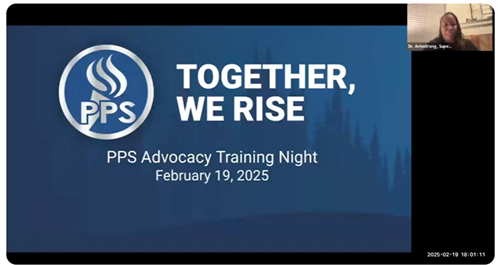-
2025 - 26 Budget Process
Frequently Asked Questions
-
 With the challenge of closing a $40 million budget gap, we have engaged the PPS community to hear the concerns of educators, students, families, and the broader Portland community. Below are answers to the questions we hear most often.
With the challenge of closing a $40 million budget gap, we have engaged the PPS community to hear the concerns of educators, students, families, and the broader Portland community. Below are answers to the questions we hear most often.
Frequently Asked Questions
-
What is the Superintendent’s Proposed Budget?
To close the budget gap, we’re facing the difficult reality of making reductions across both district-wide and school-based operations. Our goal is to prioritize keeping support for students and classrooms as strong as possible, but these cuts are necessary to balance our budget.
Learn more in the Superintendent’s Budget Message presented to the Budget Committee on April 22.
For more detailed information, see the budget documents Volume 1 and Volume 2: School Reports.
-
Does the Proposed Budget include cuts to Central Office?
Yes, the Central Office, including both central services and centrally-managed services deployed to school, sites will be reduced in the upcoming school year.
The district estimates school-based reductions will be about $23 million while reductions to Central Office will be about $20 million.
-
What is changing at my school? How can we influence how individual schools are staffed and resourced?
For detailed information, see the budget document Volume 2: School Reports.
Principals are critical decision-makers tasked with creating their school’s budget and staffing plan. Connect with your building leader to share your priorities and insights.
-
What are the potential impacts of the changes to federal funding?
We are actively tracking shifts at the federal level and have been hearing from state officials and those closely connected to the federal government that there may be a 25% reduction in Title I funding. This would have a direct impact on schools, specifically affecting intervention staffing and student support services. Additionally, Title II and Title III funding, which support professional learning and migrant education, could also see cuts.
While we’re planning for these reductions, those decisions are not finalized, and it’s difficult to fully anticipate the extent of the impact without that clarity. We’ve already started early planning, particularly for the potential reduction in Title I funding, and will continue to share updates with you as soon as we have more information. We understand how concerning this uncertainty can be, but please know we are actively engaging in this process and will keep our community informed every step of the way.
We are committed to navigating these changes thoughtfully, with a focus on minimizing the impact on our students and staff, and ensuring we have the necessary support to continue serving all our learners.
-
What will be the impact on vulnerable students?
At PPS, we are deeply committed to supporting all of our students, including those in specialized programs. We remain dedicated to ensuring that students’ Individualized Education Programs (IEPs) and state-mandated supports are fully met.
Next year, we expect an increase in our special education population, and as a result, we are planning to increase special education staff to better support these students. It's important to note that students with disabilities are supported not only by special education staff but by staff members across the district.
Despite these challenges, we are actively seeking external resources, such as grant funding, to maintain critical services for vulnerable students, including Multilingual Learners and students in specialized programs.
We also want to highlight that special education is significantly underfunded at the state level. As we work to increase our staffing to meet the growing needs of our students, it's vital that we advocate for additional special education funding in Oregon. With a strong, united voice across the state, we can advocate for the necessary changes to ensure our students receive the support they deserve.
We are anticipating a reduction to federal Title programs which support low-income and other vulnerable students.
-
Is it possible to make additional reductions to the Central Office in order to avoid cuts to school-based services?
While the Central Office is not immune to reductions, the services it provides—including staff support, instructional resources, security, facilities and custodial operations, Human Resources, payroll, communications, and technology—are essential to keeping our schools running smoothly.
-
Why are cuts to school-based services necessary?
School districts receive funding on a per student basis by statute in Oregon. With declining enrollment (similar to other districts) and the current $40 million budget gap, funds are not adequate to maintain current staffing levels. The staffing formula is applied to general fund positions and yields fewer staff where there are fewer students.
We have worked closely with our demographer and principals to ensure that staffing levels are aligned with actual student enrollment, and we are committed to maintaining the highest possible quality of education while trying to minimize any disruption to the learning environment.
-
How were budgeting decisions made? What is the justification for the cuts and priorities?
PPS leadership deeply understands the impact that budget reductions have on our schools and students, and our top priority is to preserve services that have the greatest impact on students’ personal and academic success.
Decisions have been made with great care, guided by community feedback, enrollment trends, revenue projections, and the critical need to protect programs that improve student outcomes and student supports.
Our leadership team carefully reviewed several scenarios before settling on the preliminary plan, always mindful of the challenges every cut presents. Following the release of our preliminary plan, community and principal feedback was key in further understanding impacts and refining the decisions.
We are hopeful that by making these difficult but thoughtful decisions now, we can build a more sustainable future for our schools so that every student has the opportunities they deserve to succeed.
Pictured: One of PPS' Budget Engagement meetings in February 2025.
-
What has been reduced in the Central Office over the past few years?
Over the past few years, PPS has made strategic reductions to Central Office costs, all while working to protect funding for our classrooms:
-
-
2022-23: $30 million in cuts to Central Office budgets to ensure continued funding for schools.
-
2023-24: A hiring freeze for non-teaching positions and $10 million in cuts to non-personnel expenses.
-
2024-25: An additional $15 million reduction in Central Office services and outside contracts.
-
-
-
How many FTE (full-time equivalent) are reduced in the Proposed budget?
Volume 1 estimates changes from the current year Adopted Budget to the Proposed Budget; for All Funds there is an estimated FTE change of about 183 FTE. See pages 194 and 195 for more information on functions and employee types impacted. NOTE: this does not include positions that were added to support students during the current school year.
Budget presentations and Volume 2: School Reports present preliminary estimates and compare the Proposed Budget to current staffing levels. These presentations seek to emphasize the actual impact of the position changes experienced in the upcoming school year. There will be differences in FTE amounts based on information shared at different points in time and depending on the funds that are included.
-
What are the opportunities to receive information and provide feedback?
We encourage you to visit our budget engagement event page, where you'll find details about past and upcoming events related to the 2025-26 budget. This is a great way to stay up to date on how decisions are being made and how you can participate.
-
What can we do to advocate at the state level?
PPS is committed to advocating for increased education funding at the state level, and we encourage our educators, families, and the community to join us in this effort. Legislative action and community support are essential for securing the additional resources our schools need.
-
-
PPS is actively engaging with lawmakers to push for increased funding for education.
-
We encourage educators, families, and community members to get involved in advocacy efforts to amplify our collective voice.
-
Challenges related to state funding impact the financial planning and resources available to our district, making it crucial to advocate for change.
-
You can find resources and more information on how to get involved in advocacy efforts through our Advocacy Toolkit.
We hosted a 1-hour Advocacy 101 class in February, and we invite you to watch our Advocacy 101 video and use the resources we’ve provided.
Together, we can make a difference and ensure our students and educators receive the support they deserve.

Click here to open our Advocacy Night Training on our YouTube channel. -
-
What are the impacts to Language Access Services?
While the district has made the decision to eliminate five full-time Language Access Specialist (LAS) positions for the upcoming school year, Portland Public Schools is not eliminating language access services. Moving forward, the district will continue to support multilingual families through existing contracted interpretation and translation services. This decision was made based on a review that indicated greater flexibility in scheduling and increased cost-efficiency with contracted services. The District remains fully committed to ensuring that all multilingual families have uninterrupted access to the interpretation and translation support they need.
-
Where can I find more information on the May 2025 bond renewal that is on the May ballot?
See the Bond 2025 website for more information.
-
Is the district creating more blended classrooms?
Some PPS schools already have blended grade classrooms. In 2025-26, more blends will occur in the intermediate grades (3-5) based on the projected classroom enrollment. Students will have the same teacher and will receive grade-level instruction. Building leaders and teachers will receive support through curriculum guidance and professional learning.
-
How are PERS rates impacting the budget?
PPS is a public employer required to participate in the Public Employee Retirement System (PERS). Public employers receive new rates to support deferred income obligations to retired staff every two years. The rates are driven by investment market performance and employer contributions. Last fall, PPS received the 2025-27 based on the 2023-25 valuation period with an average increase of 6.5 percentage points. Each $1 of payroll for eligible employees will also include an additional 6.5 cents towards the PERS obligation. The budgetary impact of this increase alone is $32 million in 2025-26.
-
Has the district considered the cost savings from closing schools?
PPS does not plan to close any schools in 2025-26.
The most important factor is the student experience. When school staff are spread too thin across many under enrolled schools, students do not benefit from a vibrant school community with robust programming.
With that lens in place, any savings of school closures vary by circumstance depending on location of schools, after closure use of property (sale, lease, etc.), and staffing changes.
-
Did closing the PPS PEC print shop save the district money?
The print shop located at the Prophet Center was closed effective July 1, 2024 and the closure is reflected in the 2024-25 Adopted Budget. The district anticipates an overall savings of approximately $500k in printing and binding in the current year, with about $375k attributed to the closure of the print shop. The remainder is a reduction in copy machine charges in buildings.
-
How are reserves used in the Proposed Budget?
The general fund balance is 5-10% of revenue based on board policy. The fund balance was intentionally reduced in the 2024-25 year to 5% in order to minimize additional budget reductions. The 2025-26 Proposed Budget assumes 5% as well.
The district also plans to utilize the full PERS Stabilization Reserve Fund (Fund 225) of $24 million that has been set aside to address anticipated PERS increases. This is a one-year solution to a multi-year challenge.


